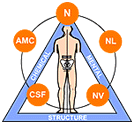


Historical View of Neural Organization Technique from its Founder Dr. Carl Ferreri

** INTERVIEW **
Dr. Carl A. Ferreri
November 17, 1985
By Carolee Trefts
Question: What is Dyslexia and Learning Disabilities?
What is Dyslexia and Learning Disabilities?
Dyslexia and Learning Disabilities is defined as the inability to process language whether it be spoken, written or symbolic. However it is a condition that goes dramatically beyond the academic world.
It is true that language seems to be natural and pre-programmed within the brain. An example is that children will learn rapidly and use correct syntax. Nobody has to teach them this. So any condition such as dyslexia that interferes with the processing of language will have obvious ramification.
There are dramatic emotional overtones involved and it is not something that just starts at 9:00 and ends at 3:00 during school hours. It is a 24 hour a day problem. Most children and many adults have no true conception of time. Directional movement such as right left up or down sometimes becomes a difficult situation for them. They all have a certain amount of disequilibrium and motion is a disturbing event. Evidence of that is that most if not many people who are truly dyslectic will tend to fall asleep after driving continuously for an extended period of time on a highway because there is a hypnosis effect from the passing of objects on the road (guard rails, fences, poles etc.) This causes a peripheral vision distraction (a common weakness) to the point where they can literally fall asleep at the wheel.
There is a sense of inadequacy within the individual, they know there is something wrong but that they can't put their finger on it. They know they are not stupid but they can't prove it. From my recent investigating the leading if not the cause of teenage suicide can be linked to this feeling.
Recent research by Dr. Levine at Mt. Sinai hospital in Mass identified this problem as the most common cause of promiscuous fires by teenage boys.
A high correlation of accidents can be related to this condition as there are deficits in depth of field. Monocular vision and muting of colors are common conditions.
Speech impediments and stuttering /hesitant speech are common problems. Sharp emotional swings are often present. With teenagers it is often very difficult to carryon a conversation. It's ‘always an argument’, they overreact to everything. This is their world of overreacting.
There are so many problems and it is so complex that it goes so far beyond the accepted definition. We must understand this! It is literally a life threatening condition.
~~~~~~~~~~~~~~~~~~~~~~~~~~~~~~~~~~~~~~~~~~~~~~~~~~~~~~~~~~~~~~~~~~~~~~~~~~~~~~~~~~~~~~~~~
Question: Is it true that a defect in the brain causes the various types of Learning disabilities?
No, fortunately. However many practitioners don’t keep up with the latest research and they may still say it is minimal brain damage or mental retardation. Actually it has nothing to do with the anatomical brain. The brain itself electromagnetically is not functioning properly.
Researchers to date have been trying to isolate a pathological process. MRI’s have found in the brains studied that the right posterior lobe is larger than the left. And the left anterior lobe is larger than the right. They also found and extra wrinkle or fold in the brain cortex with the tissue moving away from this area.
In the research that I have been doing we look at the box the brain comes in. It’s called the skull. I have found a very specific distortion pattern in the skull and that accounts for the difference in the shape of the brain because that is precisely what one would find if the sphenoid bone of the cranium was tilted high on the right and the occiput tilted low on the right. The resultant torque of this abnormal position within the normal respiratory' movements of the skull creates a significant distortion within the electromagnetic energy and its force lines. These force lines are laid down within the hard tissues (the immutable tissue), which is the bony structures of the cranium. So if there is a fault within structure. Then there will be a fault in the function of the skull. Structure and function go together.
It is only recently that most physicians and investigators agree that the cranial bones do move in normal respiratory and physiological motion. If the bones do move. Than they can moved. This is precisely what we do. We re-align or actually align for the first time the bones of the skull specifically the central structure called the sphenoid bone. Other key cranial bones are the temporal bones or lateral bones of the skull where the ear and vestibular balance mechanism is located, and the frontal bone and occiput in relation to the sphenoid. So, we are dealing with four of the major cranial bones that are known to be in association with dyslexia and learning disabilities. And there is a specific cranial bone distortion pattern found in each every and all dyslectics and it doesn't vary.
What I described is the first and critical part of any therapy we provide. There are many additional neurophysiological factors that involve eye tracking and teaming, auditory processing and specific academic skills.
Also, I would be remiss not to mention emotional involvement and the self esteem issues.
CAF ...1985
Neural Organization works as its name implies is to reestablish optimal brain function and that certainly applies to upper brain function, i.e. language process. Below is an discussion of the same topic from the originator of the work..
For additional information please email me and certainly review the information on the internet from websites: Keith Keen, D.C. Susan Walker, D.C. Alweena Awan, Ph.D.

